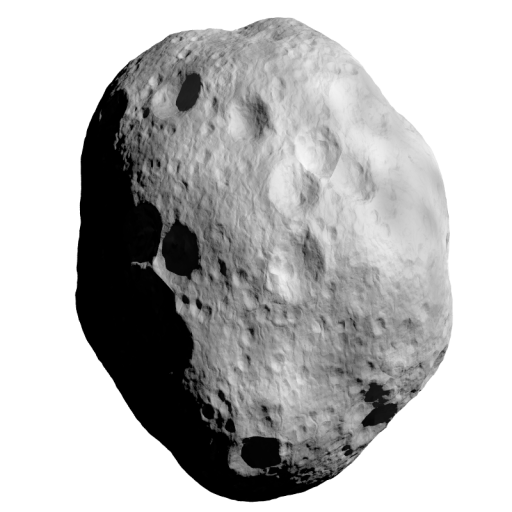Key Facts
- Categorized as a Aten-class Asteroid
- Comparable in size to the U.S. Capitol building
- Will pass within 17,907,140 km of Earth in 2033
- Classified as a Near Earth Asteroid (NEA)
- Not a Potentially Hazardous Object
- See orbit simulation
Overview
141424 (2002 CD) is a very small asteroid whose orbit could bring it in close proximity to Earth. NASA JPL has classified 2002 CD as a "Near Earth Asteroid" due to its orbit's proximity to Earth, but it is not considered potentially hazardous because computer simulations have not indicated any imminent likelihood of future collision.
2002 CD orbits the sun every 354 days (0.97 years), coming as close as 0.81 AU and reaching as far as 1.15 AU from the sun. Based on its brightness and the way it reflects light, 2002 CD is probably between 0.129 to 0.577 kilometers in diameter, making it larger than 90% of asteroids but tiny compared to large asteroids, very roughly comparable in size to the U.S. Capitol building.
Close Approaches
2002 CD's orbit is 0.07 AU from Earth's orbit at its closest point. This means that there is a wide berth between this asteroid and Earth at all times.
2002 CD has 41 close approaches predicted in the coming decades:
| Date | Distance from Earth (km) | Velocity (km/s) |
|---|---|---|
| Dec. 8, 2033 | 17,907,140 | 7.286 |
| Oct. 28, 2034 | 22,105,900 | 5.879 |
| Jan. 20, 2035 | 25,136,221 | 4.570 |
| Sept. 17, 2035 | 29,743,646 | 7.268 |
| March 4, 2036 | 25,826,627 | 5.702 |
| April 11, 2037 | 17,116,819 | 5.279 |
| May 3, 2038 | 14,639,700 | 7.799 |
| Dec. 11, 2065 | 20,345,832 | 8.193 |
| Nov. 5, 2066 | 20,516,392 | 5.546 |
| Jan. 6, 2067 | 23,695,488 | 3.898 |
| Sept. 23, 2067 | 28,836,895 | 7.165 |
| Feb. 27, 2068 | 26,447,963 | 5.676 |
| April 4, 2069 | 19,428,993 | 5.373 |
| June 25, 2069 | 27,731,545 | 3.898 |
| May 3, 2070 | 12,016,654 | 6.915 |
| Dec. 12, 2097 | 20,912,219 | 8.371 |
| Nov. 7, 2098 | 20,332,142 | 5.494 |
| Jan. 3, 2099 | 23,382,760 | 3.717 |
| Sept. 24, 2099 | 28,742,806 | 7.150 |
| Feb. 26, 2100 | 26,459,751 | 5.662 |
| April 4, 2101 | 19,603,755 | 5.397 |
| June 28, 2101 | 27,910,946 | 4.039 |
| May 4, 2102 | 11,976,817 | 6.854 |
| Dec. 10, 2129 | 17,605,018 | 7.078 |
| Oct. 27, 2130 | 22,795,064 | 5.965 |
| Jan. 25, 2131 | 25,342,024 | 4.778 |
| March 7, 2132 | 25,561,008 | 5.715 |
| April 14, 2133 | 16,660,436 | 5.247 |
| May 5, 2134 | 15,683,421 | 8.014 |
| Dec. 5, 2161 | 16,372,374 | 5.861 |
| Oct. 16, 2162 | 25,049,589 | 6.452 |
| Feb. 6, 2163 | 26,340,348 | 5.251 |
| March 16, 2164 | 24,205,958 | 5.688 |
| April 24, 2165 | 13,666,349 | 5.300 |
| May 5, 2166 | 20,749,394 | 9.231 |
| Dec. 3, 2193 | 16,513,358 | 5.585 |
| Oct. 14, 2194 | 25,560,288 | 6.541 |
| Feb. 9, 2195 | 26,458,873 | 5.336 |
| March 18, 2196 | 23,909,154 | 5.666 |
| April 25, 2197 | 13,292,525 | 5.343 |
| May 5, 2198 | 21,459,769 | 9.400 |
Images and Observations
2002 CD's orbit is determined by observations dating back to Feb. 1, 2002. It was last officially observed on July 26, 2007. The IAU Minor Planet Center records 297 observations used to determine its orbit.
Accessibility and Exploration
2002 CD can be reached with a journey of 410 days. This trajectory would require a delta-v of 8.585 km/s. To put this into perspective, the delta-v to launch a rocket to Low-Earth Orbit is 9.7 km/s. There are 118,067 potential trajectories and launch windows to this asteroid.
See more at the NHATS Mission Trajectories table for 2002 CD.
Similar Objects
These objects have orbits that share similar characteristics to the orbit of 2002 CD:References
Search
or view a random objectOrbital Elements
- Epoch: 2460200.5 JD
- Semi-major axis: 0.9799 AU
- Eccentricity: 0.1768
- Inclination: 6.88°
- Longitude of Ascending Node: 8.67°
- Argument of Periapsis: 331.8°
- Mean Anomaly: 232.44°
Physical Characteristics
- Diameter: ~0.353 km
- Magnitude: 20.65
Derived Characteristics
- Orbit Period: 354 days (0.97 years)
- Avg. Orbit Speed: 30.11 km/s
- Aphelion Distance: 1.15 AU
- Perihelion Distance: 0.81 AU
Map Comparison
Orbit Simulation
Sky Map
The position of 141424 (2002 CD) is indicated by a ◯ pink circle. Note that the object may not be in your current field of view. Use the controls below to adjust position, location, and time.
Size Rendering
The below comparison is an artistic rendering that uses available data on the diameter of 2002 CD to create an approximate landscape rendering with New York City in the background. This approximation is built for full-resolution desktop browsers. Shape, color, and texture of asteroid are imagined.

